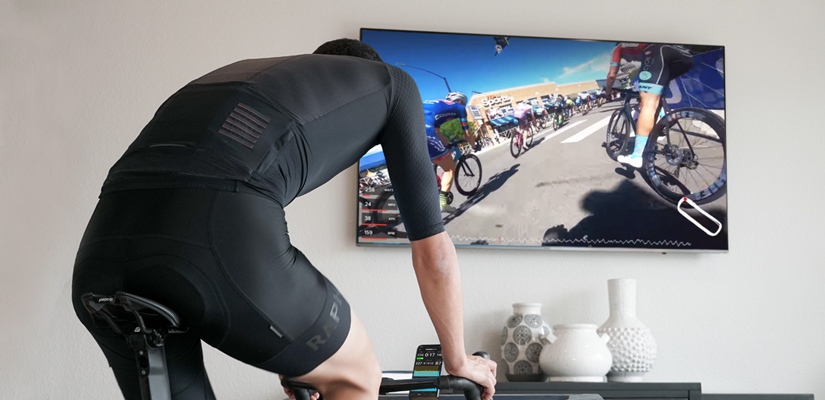Stationary bikes are a great piece of equipment for people of all fitness levels and experience. They’re a popular choice for those wanting a solid cardio workout and are often utilized by beginners and competent athletes alike to build strength in the legs as well as increase cardiovascular endurance.
They’re also ideal for those who are recovering from injury as they are relatively low-impact, especially when you compare them to the impact of treadmills and other cardiovascular machines, which is crucial if you have any difficulties with your knees or hips.
However, just getting on the bike and pedaling for the sake of it can soon become pretty tedious. You’ll find it to be extremely repetitive and are likely to lose all motivation fairly quickly. Instead, in order to get the most out of your training, it’s advised you have a planned workout in mind so that you have an internal goal you’re aiming to achieve. It’ll act as an incentive to continue to get on the bike and push you all the way throughout each ride.
So whether you’re looking to add some diversity to your training schedule, are getting into fitness for the first time, are wanting to burn some calories, or are looking for new workouts to take your training to the next level, here we’ve explained some of our favorite stationary cycling challenges that people of all capabilities can partake in.
Bike Interval Training
To get the biggest benefit from exercising on a stationary or spin bike, we recommend that rather than just cycle for extended periods of time at a steady constant pace, you take part in interval training instead. It involves a series of stints of exercises whereby you work at a certain level of intensity for a specified period of time, followed by a low-intensity recovery period.
The intense effort you put in means that your body must work harder to recover, causing you to burn more calories in the hours after your workout than you would after a slower but longer run. It also helps to improve your speed and endurance as your body learns to burn lactic acid more efficiently, allowing you to continuously exercise for longer before fatigue kicks in.
Below we’ve outlined an example of the type of interval session you might want to incorporate into your indoor exercise bike training, but you can of course tweak the intensity, duration and rest period where appropriate to suit your personal ability and goals.
Before you get started, here we’ve provided a quick guide to the various levels of intensity –
Low intensity – Set the bike to a low resistance, and keep to a pace that you could comfortably hold all day.
Moderate intensity – Slightly increase the resistance so it feels like you’re cycling up a slight incline. Your breathing will be a touch heavier, but you’ll still be able to have a conversation.
Hard intensity –You should be cycling at a medium-heavy resistance, and it is tough. You’d be able to put one or two words together, but you really don’t want to.
All-out intensity – Set the bike to the highest resistance you can handle and give everything you’ve got.
- 5 minutes – Low intensity (warm-up).
- 4 minutes 30 seconds – Alternate every 45 seconds between hard and moderate intensity.
- 1 minute – Low intensity (recovery period).
- 6 minutes – Alternate every 45 seconds between hard and moderate intensity.
- 1 minute – Low intensity (recovery period).
- 3 minutes – Alternate between all-out and low intensity (45 seconds at all-out, followed by 15 seconds of low).
- 2 minutes – Low intensity (recovery period).
- 5 minutes – Low intensity (cool-down).
If you’re looking to really push yourself and are up for an extra challenge, repeat the entire circuit once more.
HIIT Training Workouts
Standing for high-intensity interval training, HIIT workouts focus on using short bursts of activity to really get your heart pumping. Unlike interval training, for these sessions you use the same resistance throughout, but vary the intensity you work at. The intervals you work at are also shorter.
This type of training can provide a wealth of benefits, most notably improved oxygen consumption (your muscles’ ability to use oxygen), fat loss and muscle gain.
Below is an example of a HIIT cycling workout that might appeal to you. Remember to use the same resistance (make it one that provides enough resistance to keep your pedal strokes smooth and controlled).
- 5 minutes – 30-40% intensity (warm-up).
- Repeat the following 5 times –
- 30 seconds – 50-60% intensity.
- 20 seconds – 70-80% intensity.
- 10 seconds – 90-100% intensity.
- 2 minutes – 30-40% intensity (recovery period).
- Repeat the following 5 times –
- 30 seconds – 50-60% intensity.
- 20 seconds – 70-80% intensity.
- 10 seconds – 90-100% intensity.
- 2 minutes – 30-40% intensity (recovery period).
- 4 minutes – 30-40% intensity (cool-down).
Virtual Cycling Challenges
To get the greatest value out of your workouts, you need to regularly take to your exercise bike. Those who only go for rides sporadically might feel a burn now and again, but won’t actually be making serious improvements as they’re not building on their progress.
A great way for making sure you get into a frequent habit of riding your exercise bike is to enter a virtual cycling challenge. It’s a popular challenge that requires you to cycle a specified number of miles however fast or slow you like, and in as many stints as you need, in the space of a month. All you need to do is keep a record of the distance you’ve covered, and once you’ve successfully completed the challenge, you’ll receive a prestigious medal as a reward for your hard work and dedication!
By participating in one of these challenges, you’ll be more likely to want to get on the bike as you know the countdown is on and need to get the miles clocked before the turn of the month. Ranging from 50 to 600 miles, there are challenges of varying distances available, enabling people of all abilities to enter.
Happy Riding !!



